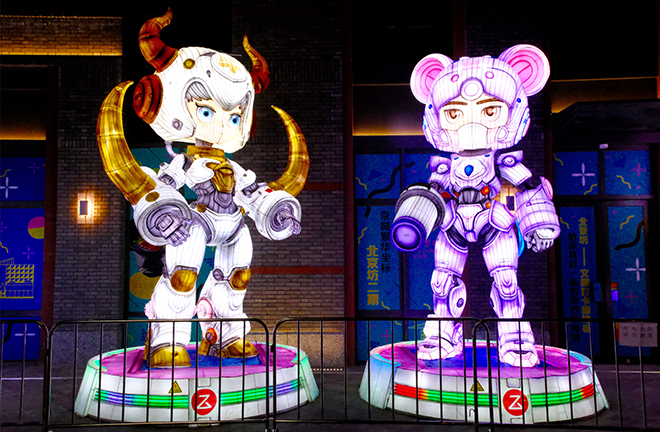Incorporating contemporary urban society into folklore studies

In April 2025, the intangible cultural heritage lantern exhibition at Beijing Fun Complex on Qianmen Street in Beijing showcases the innovative fusion of traditional Chinese culture and modern technology. Photo: IC PHOTO
Although numerous books and articles have been published with the term “urban folklore studies” in their titles, the field is far from well-developed as a branch of folklore studies. It lacks distinct research objects that distinguish it from other subdisciplines, and the existing body of research remains limited. Nevertheless, the city is a vital arena of contemporary Chinese folk life, and urban folklore studies holds great potential.
Implications of the city for folklore studies
Modernity has become the mainstream of urban folk life. While traditional folk customs still have their place in urban society, they no longer occupy a dominant position. Unlike rural folk life rooted in agriculture, urban folk life is built upon modern technology, industry, commerce, and culture, and is characterized by institutionalization, normativity, and diversity. Traditional forms of folklore long studied by scholars, such as folk literature, folk beliefs, and traditional festivals, have all undergone substantial transformation. In this context, folklore studies must break free from habitual frameworks and broaden its scope to encompass the everyday lives, production activities, and social interactions of urban residents.
The principles underlying the formation of folk relationships have also shifted considerably. In rural society, such relationships are primarily based on traditional ties such as kinship and geographic proximity. Even participants in cross-village folklore activities often share similar life experiences, habits, and behavioral patterns. In contrast, folk relationships in urban society are formed amid unfamiliarity and difference among individuals. Even neighbors living in close proximity may vary in terms of economic status, educational background, moral values, and occupations. As a result, many urban folk activities are characterized by short-term, limited interactions. Urban folklore studies must therefore examine the patterns and formation mechanisms of diverse folk practices and analyze the internal structure of various folk relationships.
Normative institutions govern all aspects of urban social life. Modern bureaucracy is the prevailing organizational structure in urban society, where institutional organizations such as schools, companies, hospitals, and government agencies play a leading role. In such a society, social life is strictly regulated by rules, and formal relationships grounded in normative institutions take precedence over other forms of social relations. Actions are guided by rules, a clear division of labor, well-defined responsibilities, and controllable outcomes. Social activities and customs are typically the result of deliberate design, while traditional modes of production and ways of life shaped by natural endowments have largely lost their social foundation for continued existence.
Potential approaches tostudying urban folklore
Understanding public sentiment through trends and fashions: Urban society is a breeding ground for new cultural expressions, where emerging trends reflect not only the dynamics of the city itself but also broader regional, national, and historical contexts. By examining the prevailing trends, researchers can discern the differing preferences of various groups and gain insight into how individuals are connected to their city, region, and nation.
Reflecting social mechanisms through individual narratives: Folklore studies excels in narrative-based research—from oral histories to regional ethnographies, from folk literature to ritual practices rooted in folk beliefs. The focus on narrative not only enables folklore studies to transcend both the urban–rural divide and traditional paradigms but also provides a solid foundation for urban folklore studies to establish its academic legitimacy. On one level, it allows for the use of individual stories as windows into the broader urban society constructed by its members. On another, it offers a more nuanced and affective understanding of the lives of city dwellers through individual stories.
While the prospects for urban folklore studies are promising, embracing the city and modernity presents a significant challenge. Urban folklore shaped by modernity has largely been absent from conventional disciplinary frameworks and theoretical models, and research on contemporary folklore or modern urban folklore struggles to gain recognition within the academic community. Nevertheless, to keep pace with ongoing societal changes, folklore studies must engage with current social realities and actively respond to the new developments in China and the world since the modern era. A crucial task for the discipline going forward is to acknowledge modern urban folklore while also encompassing traditional and rural folklore, ultimately developing a new type of folklore studies that transcends both geographic and temporal boundaries.
Deng Miao is a lecturer from the College of Arts at Beijing Union University.
Edited by WANG YOURAN
